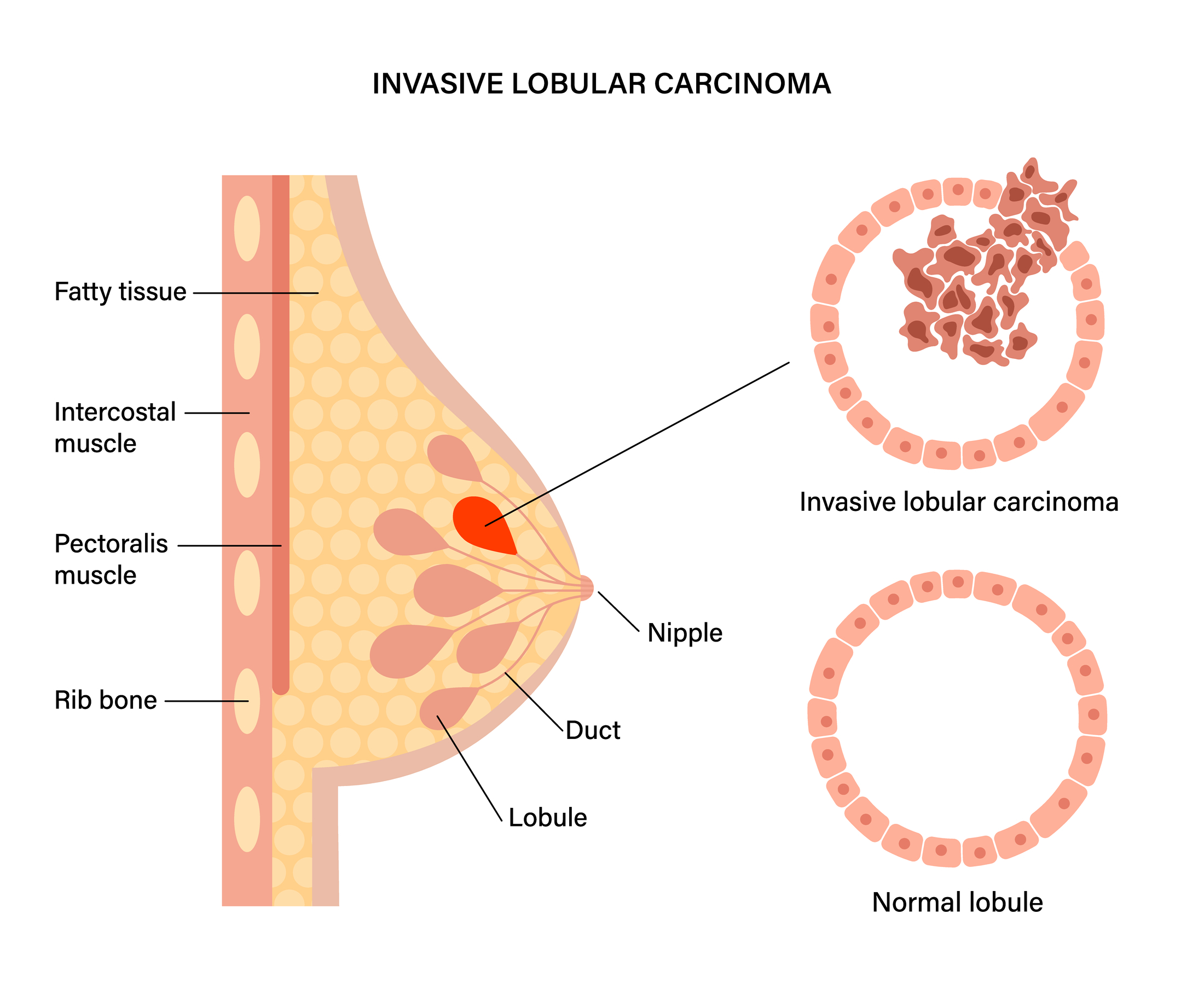Invasive Lobular Carcinoma

Breast cancer that starts in the lobules that produce milk is known as invasive lobular carcinoma. Invasive cancer has expanded beyond the initial lobule it started in and has the potential to affect the lymph nodes and other parts of the body. Little of all breast malignancies are invasive lobular carcinomas. The breast ducts are where the most prevalent kind of breast cancer occurs (invasive ductal carcinoma).
After invasive ductal carcinoma, invasive lobular carcinoma (ILC) is the most prevalent kind of breast cancer (IDC). According to the American Cancer Society, invasive lobular carcinomas make up around 10% of all breast malignancies.
Staging:
The features of the tumor, such as its size and whether or not it possesses hormone receptors, indicate the staging of invasive lobular carcinoma. Your doctor and you both benefit from knowing cancer's stage, as it can help to
- Ascertain your prognosis or the likelihood that the condition will progress
- Choose the most effective course of action for you
- See whether participating in a few clinical trials could be a good idea for you
On a scale from I to IV, a number often represents the stage of invasive lobular carcinoma. Stage IV indicates malignancies that have migrated outside the breast to other areas of the body, like the bones or liver. Stages I, II, and III represent early-stage cancers.
Your doctor will order more tests after determining that you have invasive lobular carcinoma to learn more about the features of the disease. The components of your pathology report include these examinations and the outcomes of your biopsy.
Diagnosis:
Although invasive lobular breast cancer grows more slowly than other types of breast cancer on a relative basis, the tumors may already be enormous by the time they are discovered. In response to a mammography finding of concern or your observed symptoms, your doctor could suggest further screening tests such as:
- There are fewer chances of visible lumps. magnetic resonance imaging (MRI): Conducted after mammography, a breast MRI generates detailed pictures of the breast's interior that can be used to identify any new tumours or signs of cancer that have progressed to the breast.
- Breast Ultrasound: Using a transducer to transmit painless sound waves through the skin, ultrasonography can detect cancers.
- Breast Needle Biopsy: A radiologist uses a needle to extract a tiny bit of breast tissue after numbing the breast region. A pathologist, a medical professional who analyses tissue for indications of disease, receives the sample and examines it under a microscope to affirm or reject the presence of cancer cells.
Symptoms:
ILC has a distinct course of development compared to more prevalent breast cancers. There are fewer chances of visible lumps. There may not be any symptoms or indicators in the early stages. But when the disease advances, you could observe changes in your breasts.
- Localised thickening or hardening
- Swelling or feeling heavy in a specific location
- Changing the texture or appearance of the skin, such as the development of dimpling
- Change in size or shape
- Newly inverted nipple
Other indications might be:
- Breast discomfort
- Nipple discomfort
- A lump under the arm
- A discharge other than breast milk
Treatment:
There are two types of ILC treatment: local and systemic. Local treatments focus on the tumor and its surroundings, whereas systemic treatments travel throughout your body, killing any cancer cells that have spread. Treatments for invasive lobular carcinoma at the local and systemic levels. Local treatments include the following:
- Surgery. In most cases, this is the first line of treatment for invasive lobular carcinoma. To remove the tumour, a lumpectomy or mastectomy is performed. Your surgeon will also check to see if the cancer has spread to your lymph nodes during the procedure.
- Radiation Treatment. This procedure directs high-energy radiation rays at your breast, underarms, and surrounding areas. Following surgery, radiation therapy is frequently recommended to destroy any remaining cancer cells.
Systemic treatments include the following:
- Chemotherapy - Drugs are used in this treatment to kill cancer cells. It could be used before surgery to shrink the tumour. It could also be used after surgery to eliminate any remaining cancer cells.
- Therapy that is targeted - This type of treatment destroys cancer cells by targeting specific characteristics of the cells. Targeted therapy is less likely to destroy healthy cells than chemotherapy.
- Hormone replacement therapy - Antihormone therapy may be an option if cancer tests positive for hormone receptors, which most ILCs do. This method reduces the amount of oestrogen in your body. As a result, it either prevents or slows the growth of breast cancer cells.
Risk factors:
You're more likely to get ILC if you're:
- Female or assigned as a female at birth (AFAB)
- AFAB and taking hormone replacement medication (HRT)
- Post-menopausal
- Carry cancer-causing genes.
If you have received a diagnosis of lobular carcinoma in situ (LCIS), your chance of acquiring ILC may rise. LCIS is characterized by the discovery of atypical or abnormal cells that are restricted to the lobules and have not penetrated the surrounding breast tissue.
LCIS, which is not cancer, is a rare condition.
Conclusion:
Breast cancer that begins in the milk-producing ducts or lobes of your breasts is known as invasive lobular carcinoma. If it is diagnosed and managed before it spreads beyond your breasts to adjacent lymph nodes, this slow-growing cancer can be cured. The signs of less severe conditions may mirror those of lobular carcinoma. Do not be reluctant to speak with a healthcare professional if you detect changes.






